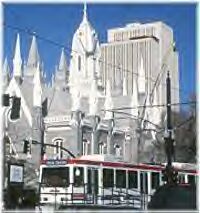
Light Rail Progress can be contacted at: Light Rail Progress lightrailnow@lightrailnow.org |
Yet another brand-new light rail transit (LRT) system is besieged with passengers. This time, it's Salt Lake City's new TRAX LRT, which opened in December 1999, and has grown dramatically in popularity ever since.
Installed and operated by the Utah Transit Authority (UTA), TRAX's original line runs 15.0 miles from Delta Center in downtown Salt Lake City to the southern suburb of Sandy. LRT trains travel up to 55 mph, making the run in 38 minutes, and serving all 16 stations – at an average speed of about 24 mph.
From the start, TRAX was a hit. At about $300 million, total project cost came in millions of dollars under budget (about $22.8 million/mile, in 2002 dollars). Ridership exceeded projections by 40-50%. To respond to the demand, headways were shortened (i.e., frequency of train service was increased) and trains were lengthened (to 3-car trains instead of 2-car) at peak hours to handle the additional passengers. On top of all that, LRT brought huge operating cost savings. For
the full first year of operation, 2000, operating cost per passenger-mile by TRAX plunged to $0.15, compared with $1.04 for UTA's
bus operations. Success of the initial TRAX line stimulated community enthusiasm for extensions. in November 2000, voters approved an additional quarter-cent sales tax to fund transit expansion.
Because of the disruption of streetwork, UTA developed a plan to
work with businesses impacted by TRAX University Line
construction. "Businesses had money to reward the contractor for
keeping traffic moving through the area" recounted local TV news
reporters. "And finally for those businesses, today thousands of
potential customers poured off the TRAX trains", the reporters
announced on 15 December 2001, when the University branch
opened. During the 2002 Winter Olympic Games, UTA's transit system was declared a terrific success on an international screen – safely and efficiently carrying more than four million rider-trips by Olympic visitors – who didn't cram more cars onto the city's crowded roads and freeways. Like the original starter line, TRAX's University branch was
flooded with passengers. UTA estimated ridership on the new
extension at 5,000 per day – about 900 rider-trips, or 22%, over
original forecasts. The University Line's success continued in the fall 2002 semester.
As a UTA news release reported, "students packed UTA TRAX
trains at the Gallivan Plaza Station and at the four University Line
UTA TRAX Stations this morning." "We are using every UTA TRAX train out there, to provide service on this line that has doubled projected ridership numbers in just eight months" said UTA Director of Rail Services Paul O'Brien. So, how's TRAX doing today? Onward and upward. UTA's TRAX light rail system is currently averaging more than 28,000 passengers a day along its 15-mile Salt Lake-Sandy line and the newly opened 2.3-mile University Line. UTA has become the region's multi-modal transportation leader, providing 100% accessible public transportation with 33 light rail TRAX vehicles and more than 600 buses. Most importantly, public transit ridership has surged since the
TRAX LRT came online. Total bus and LRT ridership has soared by 18.5% since 1996.
And more LRT growth is under way. UTA is currently constructing
the 1.5-mile Medical Center TRAX light rail extension which will
complete the connection between the University of Utah and
downtown Salt Lake City. And even more suburbs are clamoring
for LRT. "The folks over at the Utah Transit Authority must be delighted
with the way the TRAX light-rail system has been received" noted
an editorial in the Deseret News. Recounting Salt Lake City's initial cold feet at plunging ahead with a major rail transit project, the News pointed out that things had completely turned around. "Now," reported the paper, "cities in outlying areas are clamoring for lines out their way, to the point where Riverton now is paying $125,000 to become part of an area-wide transit and transportation study." Suburbs are queuing up with requests to be served by LRT, says the paper: "Davis County likewise wants lines out its way. So do people in West Valley City, West Jordan, Draper and other parts of the metro area." Haven't we heard that kind of clamor before – in North Texas? Salt Lake City, keep an eye on Dallas's DART LRT. TRAX seems headed for the same success. Salt Lake City TRAX Light Rail Transit
|